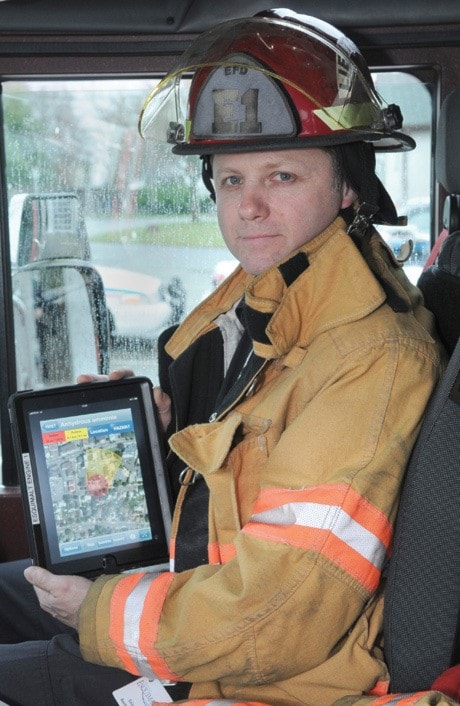Lt. Troy Saladana takes hold of the iPad mounted inside the fire truck and touches the screen of the tablet computer.
It instantly reveals a map of the nearby Esquimalt Recreation Centre, which Saladana is pretending is the scene of a hazardous chemical spill.
“We know the evac zone is here,” the Esquimalt firefighter says. “I can have this (information) sent to the (fire) chief.”
He enters an email address and presses another icon on the screen with his finger, sending off a report detailing the type of hazardous chemical, location co-ordinates, wind speed and the size of the evacuation and quarantine zones.
“Three years ago we were drawing stick figures on paper, and, if we were lucky, photocopying them and handing them out by hand,” Saladana says.
The team at the Esquimalt Fire Department believes it is the first firefighting department in B.C. to use iPads on the job.
The Esquimalt firefighters have been trying out the iPads at their fire hall for the past two months. They credit the technology for its touchscreen features, speed, small size, portability, affordability, storage and Internet capabilities, among other qualities.
The iPad technology is “so relevant, members of the department weren’t waiting for the fire department to supply them. They were bringing their own to use on the trucks,” says Esquimalt fire Chief Dave Ward.
Ten days after mounting iPads inside the cabs of a fire truck and command vehicle, firefighters used one to take photos of a crash scene last week. The pictures can later be accessed by police or the fire team for further examination and de-briefing.
The department is in the process of storing all 150 volumes of its standard operating procedures, from fire bylaws and hazardous response guidelines to fire codes and building plans of apartments and other structures in the municipality, including schools, onto its iPads.
With the touch of an icon, the team can now access information on businesses that may be due for an inspection, or the designs of vehicles involved in a crash, which can aid the team in rescuing trapped passengers.
Firefighters can also bring up floor plans of a burning building.
“If we’re running to a fire scene and we know it’s going to be at the high school (Esquimalt High), not that long ago we would use a big binder stuck in the back of the truck,” says Saladana.
“Now I go like this and I click on this … and as fast as I can do this, there’s the floor plans for the school,” he says, pressing icons on the tablet’s touch screen.
Before reaching the scene, an incident commander can access the building’s layout, occupancy and the location of fire hydrants.
“And there’s a better chance the (information on) the iPad is more current and up to date, so that makes them more reliable,” Ward adds.
The iPad technology has eclipsed the mobile data terminals mounted in most fire trucks, Saladana says, adding that compared to iPads, the terminals are not portable and don’t have Internet capabilities. Nor do they feature touchscreen technology.
Esquimalt firefighters began using mobile data terminals in their trucks about five years ago, at least five years after other departments in the province began using different forms of the terminals in their trucks, says Saladana.
“The other departments were ahead of us during that time,” Ward says. “We didn’t have the luxury of using the mobile data terminals (due to cost), but because (the iPads) are more affordable, we can now move forward and put these on the vehicles.” The department recently stopped using the data terminals.
The terminals each cost about $5,000, which easily covers the cost of two iPads, the chief notes.
Saladana believes the technology is “ground-breaking” for the emergency services industry, and says it’s only a matter of time before portable, touchscreen tablet computer technology becomes commonplace on the front lines.
“It’s coming,” he says. “There’s no way of stopping it.”
“The fire trucks will come with iPads on them,” Ward adds.
